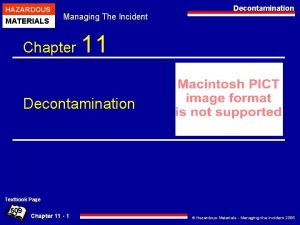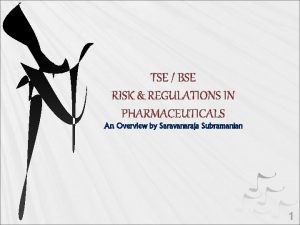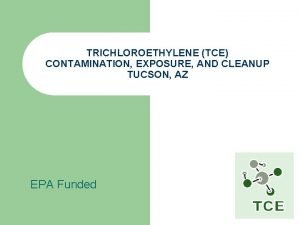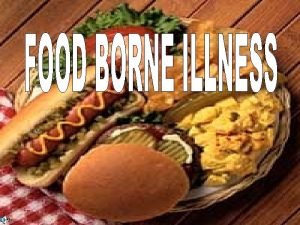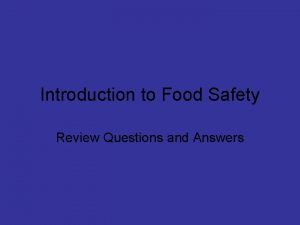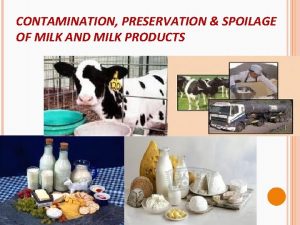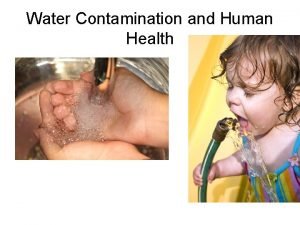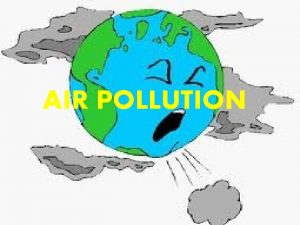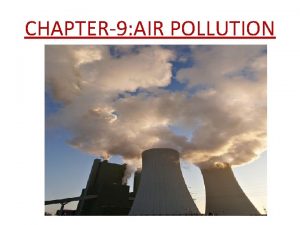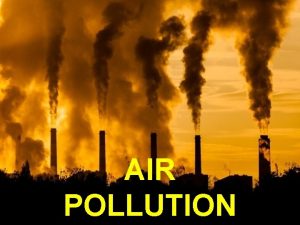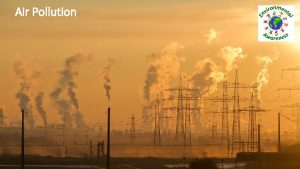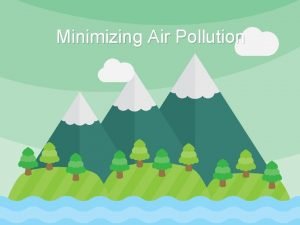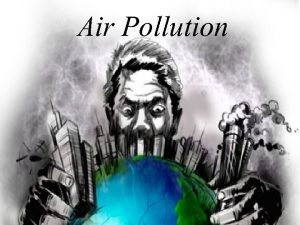Air Pollution Air Pollution The contamination of the












- Slides: 12

Air Pollution.

Air Pollution • The contamination of the atmosphere by the introduction of pollutants from human and natural sources. • Air pollution is classified according to their source as Primary pollutants or Secondary pollutants.

Primary Pollutants • Primary pollutants are pollutants put directly into the air by human or natural activity. • Natural sources include dust, sea salt, volcanic gases and ash, smoke from forest fires, and pollen. • Human pollutants include factory smoke and vehicle exhaust

Secondary Pollutants • Pollutants that form when primary pollutants react with other primary pollutants or with naturally occurring substances. • Examples: – Ozone – produced when sunlight reacts with vehicle exhaust and air – Smog – Ozone reacts with vehicle exhaust to form smog

Sources of Human-Caused Air Pollution • • • Transportation Industrial Plants/Power Plants Oil refineries Chemical manufacturing plants Dry cleaners Furniture refinishers

Acid Precipitation • Precipitation such as rain, sleet, or snow that contains acids from air pollution. • When fossil fuels are burned, they release sulfur dioxide and nitrogen oxide into the atmosphere. When these combine with water in the atmosphere, they form sulfuric acid and nitric acid.

Plants • Plants have adapted to the natural acidity of the soil. • Acid precipitation cause the acidity of the soil to increase – process called acidification • Acid levels cause nutrients from the soil to dissolve and then get washed away with rainwater

Water • Aquatic organisms have adapted to live in water with a particular range of acidity. • If acidity increases, aquatic plants, fish and other organisms may die. • Effects of acid in water is worse in the spring, because acidic snow melts. • A rapid change in the acidity of a body of water is called acid shock. • To reduce acid shock, powdered lime (a base) can be added to lakes.

Air Pollution – Effect on Humans • Daily exposure causes serious health problems. • Children, Elderly, and people with asthma, allergies, lung problems, and heart problems are more vulnerable to the effects. • Short-term effects – coughing, headaches, increase in asthma-related problems, nausea, irritation of eyes, nose and throat • Long-term effects – lung cancer, emphysema, permanent lung damage, heart disease

Cleaning up… • In 1970, Congress passes the Clean Air Act • The Clean air act gives the EPA (environmental protection agency) the authority to control the amount of air pollutants that can be released from any source, such as cars and factories. • Requires industries to use pollution-control devices, such as scrubbers (a device that is used to remove some pollutants before they are released from smokestacks)

Allowance Trading System • The Allowance Trading System is another initiative to reduce air poollution. • The EPA establishes allowances for the amount of a pollutant that companies can release. • If a company exceeds their allowance, they must pay a fine.

How can WE help? • • • Hybrid cars Recycle Carpool Use public transportation Ride bikes Use cleaner fuels
 Contamination vs cross contamination
Contamination vs cross contamination Tse/bse guidelines
Tse/bse guidelines Chapter 12 section 3 acid precipitation
Chapter 12 section 3 acid precipitation Chapter 12 air section 1 what causes air pollution
Chapter 12 air section 1 what causes air pollution Pt tanah air sentosa
Pt tanah air sentosa Food contamination monitoring system
Food contamination monitoring system Tucson tce contamination map
Tucson tce contamination map Silicone contamination aerospace
Silicone contamination aerospace Land pollution effects on human health
Land pollution effects on human health Direct contamination definition
Direct contamination definition Questions and answers for food safety
Questions and answers for food safety Thorium
Thorium Contamination of milk and milk products
Contamination of milk and milk products
